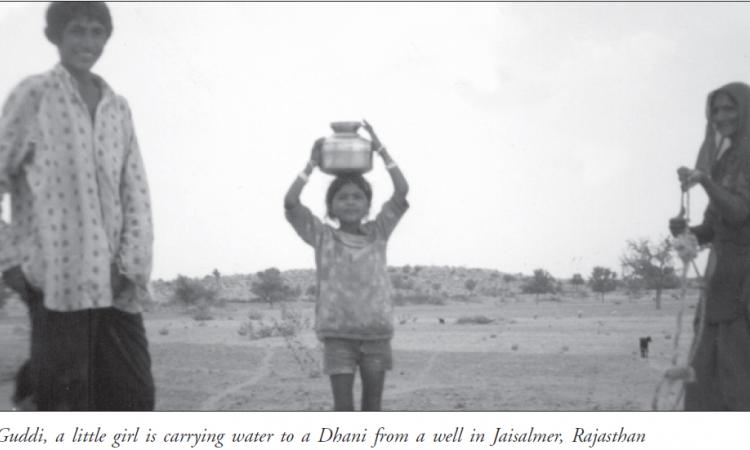
“She sends me to fetch water Very early in the morning Oh! Grandfather it is very difficult for me My pot never fills up fully The water is so deep That my rope hardly reaches it The sun rises and also sets By the time, I return Unable to collect even one pot-full of water” - A folk song of Rajasthan
This is the situation most women and girl children in semi-avid Rajasthan find themselves in for much of the year. They trudge bare foot in the hot sun for hours over wastelands, across thorny fields, or rough terrain in search of water, often the colour of mud and brackish, but still welcome for the parched throats back home. On an average, a rural woman walks more than 14000 km a year just to fetch water. Their urban sisters are only slightly better off- they do not walk such distances, but stand in the long warding queues for hours on end to collect water from the roadside taps on the water lorries. (Krishan Kumar 2003).
In every household, particularly in the rural areas in Rajasthan women and girl children bear the responsibility of collecting transporting, storing, providing and managing water. In places, where there is no water for farming, men migrate to urban areas in search of work leaving women behind to fond for the old and the children. Women spend most of their time, collecting water with little time for other productive work. This impacts on the education of the girl child, for if the girl is herself not collecting water, she is looking after the home and her siblings when her mother is away.
The chore of water collection is a back breaking having adverse effects. Regular contacts with water also makes women prone to water borne diseases such as Schistosomiasis (bilharzia) and dracunculosis spread by guina worm (Krishna Kumar 2003)
Innovative Ways to Save Water
Determined to pull themselves out of their predicament, the women have formed ‘water committees’ and revived traditional methods of water harvesting. Women have brought up potable water to their doorstep using conventional techniques. Over the years, the women of Rajasthan, have devised ways of saving water (Saksena 2003)
Bathing on a string cot so that they can reuse the water falling through, wearing bone bangles wrist upwards to the armpit so that only the hands have to be washed delivering babies on sand to avoid soiling clothes and cleaning utensils with hot sand speak volumes about their harsh life style. With the monsoon-playing truant in the last few years, the miseries have increased manifold (Saksena 2003)
Agara Bai, who is 80 years old, in Sadavatin Village of Jodhpur district in Rajasthan has seen the revival of a pond in her village. A 40-year-old village pond, which was virtually useless, now holds water to last the 500 families for a year – thanks to one inch of rain they got.
Last year and the hard work of 70 women who desalted the pond, they increased the catchment area to 4 km and built a bund wall around it. The women’s committee managing the pond has barred people from taking bath near the pond. Nor the animals are allowed to later around it. They went to keep water clean for drinking. They themselves decide how much water should be diverted for irrigation and how much to be saved for drinking and other purposes. Now, when they count their assets they also include the tanks (Saksena 2003)
To the women of Akhadhana Village go the credit for recharging the largest number of traditional beris in Rajasthan. Beri is a 40 foot deep well below the bed of pond, the mouth of which is covered by a stone lid. Raw water collected in the pond raises the groundwater table, which fills the beri to the ruin. When the pond dries up, the beri is opened to get filtered drinking water. The 100 beris desilted in Akhadhana are said to be 200 years old. (Saksena 2003)
“Water at hand is far more crucial for women than money” The revival of the system of johads in Arvari basin has had a visible impact on the socio-economic scenario of the region particularly women. In Rajasthan, the unhappy lot of fetching water has traditionally been the women. In times of scarcity, women would have to walk four to five kilometers for water. They also procure fodder and fuel wood, both of which are scarce in times of drought. The average time by women on these activities was 18 hours a day. But the johads have changed all this with water readily available to them; much time is now saved and utilized in productive work. The increased availability of water cooking, washing and bathing has definitely improved the standard and quality of life. (Kishore 2004).
Each structure of johads is small-scale but the cumulative benefits of johads are most certainly large scale. Not a single family has been displaced to achieve these impressive benefits. Unlike big dams, the johads have not destroyed any rivers or submerged huge areas of forests and farmland. Johads are cost-effective and viable options in any agro-climatic situations for conserving rainwater and recharging ground water. The structure may vary in terms of shape and size, but the technology remains the same and is easily adaptable to local conditions. The experience of Arvari catchment shows that communities are best qualified to conserve water by adopting their techniques and wisdom (Kishore 2004).
In a meeting, which was attended on Women’s day by more than 3000 women in Tonk in Ajmer district, the issue of drinking water dominated the discussion. The situation is not better in Rajamond, Bhilwara or pali. The women are queuing at the hand pump from 4 a.m and as late as 11.30 p.m., one can find women still waiting for water. (Roy 2004)
Rajasthan is India’s largest state with its area of 342,239 sq.km. It has an estimated population of 5,64,73,122 (2,93,81,657 male & 2,70,91,465 female) spread over its 41,538 villages. The economy of the state is primarily based on agriculture and animal husbandry. In Rajasthan 90% of the population is dependent on ground water for drinking and irrigation purposes. The ground water mining is continuously going on. The ground water table is going down at a rate of approximately one metre per year. The situation has reached alarming proportions in some parts of the state. As a result, the water supply systems of many towns, villages and habitations have been put under great strain due to reduction in yield from hand pumps, tube wells and open wells. The over exploitation of ground water and lack of dilution though recharge is resulting into degradation of ground water quality in many areas.
Unfortunately almost 25% of the villages in the state are suffering from presence of high level of fluoride in ground water. Nine districts of the state are having fluoride-affected water in more than 50% of the villages. More areas are reporting fluorosis problem every year because of scanty rainfall and indiscriminate exploitation of ground water. UNICEF has supported development of an integrated model for fluorosis mitigation by Government of Rajasthan involving creation of awareness about control and mitigation of fluorosis, changing dietary habits, rain water harvesting and domestic defluoridaiton through activated alumina filters. This model has been tested on the ground in the state and given noteworthy results.
Rajasthan is the most water deficient state in the country following short spell of monsoon coupled with erratic behavior and scanty rainfall. Drought is the most frequent disaster recurring in the state. The last successive four years of drought has largely eroded copping capacity and economic potential of people. All the 32 districts (41000 villages) of the state have been declared drought affected having a serious impact on the bare survival needs of people, including safe drinking water and adequate nutrition. Family food security is under threat due to considerable economic losses, and reduced agriculture output. Many poor and landless people are forced to migrate in search of livelihood leaving behind their old parents, women and children to increased risks and vulnerability of drought.
A study was undertaken to analyse the water burden on women in Jaisalmer and Sri Ganganagar districts of Rajasthan. The rural habitation in Jaisalmer and Sri Ganga Nagar could be categorised on the basis of settlement pattern into ‘gaanvs’ and dhaanis. The gaanvs being more concentrated with a high population density and the dhaanis being a location of low population density. Also it is found that the problem faced by the people living in dhaanis are quite different from those living in gaanvs. While there are tube wells in the gaanvs, the women in dhaanis collect water from open dry wells.
Almost all the villagers are engaged in agricultural activities. They are mainly land ownerlabourer or landless labourers with very low income The increased reliance Jaisalmer on rainfall made them vulnerable to the vagaries of changing weather patterns which affected their income. In Sri Ganga Nagar, to the significant extent the agriculture depends on the network of canal/ sub canals
Jaisalmer: The only source of water available in Jaisalmer is ground water at a depth of more than 200 ft. This water is tapped through dug open well, and the tube well installed under various government schemes in some “gaanvs” (village). Water from the tube well is also supplied to some other villages. The distance to water source is less incase of ‘gaanvs’ (about 100-200 metre) as compared to ‘dhaanis 2-3 km, some area even more.
Water availability: In Jaisalmer the survey revealed that water is scare for all the uses. This includes water required for drinking, personal hygiene, households uses and other activities. Typically, time spent for water collection per trip is one hour to one and half hour. Women report that 3-5 trips are made every day.
Due to irregular power supply, the tube wells are not able to run properly. When water is not available from the tube well in the village, women fetch water from tube wells in the neighbouring villages. At such times, the distance traveled for water doubles or triples to cover 6-8 kms.
Reduced water availability has also affected consumption pattern and affected lifestyles with very less amount of water being consumed per person for drinking and other activities. The amount of water consumed per day varies from mere 7.5 litres per capita daily (lpcd) to 14 lpcd for drinking as well as household activities.
Discussion with the villagers indicate that women and children suffer with a number of health problems like diarrhoea, gastroenteritis, jaundice, being more rampant in summer and rainy season. Backaches are more common among women and this may be linked with the burden of collecting water. There is hardly any sanitation facilities in the villages. Personal hygiene is also found quite dismal. People reported as being forced to take a bath only once or twice in a month. Poor quality of water as well as poor availability of water aggravates malnutrition. One distressing factor is that women do not perceive diarrhoea or jaundice as the water related problem. There are some factors, which aggravates the water related stress for instance.
With no alternative source of income in the villages, people have migrated either temporarily or permanently to other areas.
Demographic forces: Of the demographic forces, population density of settlements appeared to be an important factor; with high pressure affecting not only per capita water availability but also the quality of water at source.
Socio-economic factor: Poverty is evidently aggravator of water related stress, given the inability of poor households to invest in water collection, storage and purification. Additionally caste continues to play a role in determining access to water in some villages.
It is distressing that nearly two decades after the launch of the National Drinking Water Mission, women in our village, continue to reel under water related stress, aggravated by a gamut of natural, demographic, socio-economic and cultural factors. It is evident from the study that access to water has significant benefits for women.
In Sriganganagar district, the Public Health Engineering Department (PHED) has installed only 2132 hand pumps, which according to the report of PHED of 593 hand pumps were functioning. In fact, this number may be higher and there is no guarantee that after repairing functioned properly. Due to the less flow of water in main canal, the villages located at the extreme fail to receive the water.
The study was conducted in the following Villages and dhaanis of Fatehgarh Tehsil of Jaisalmer district.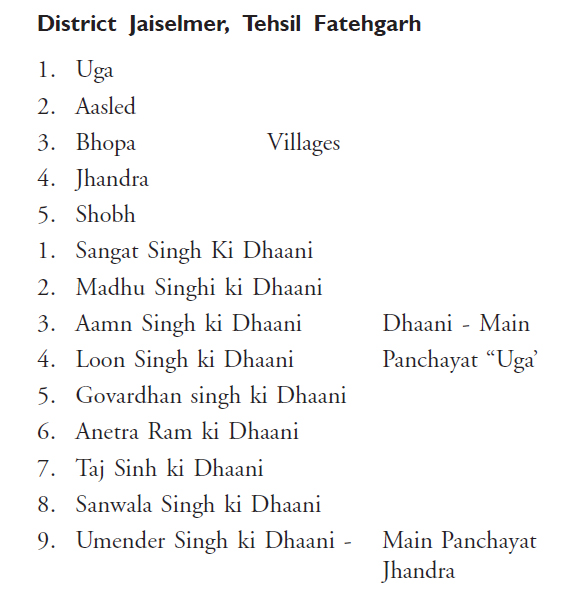 Rani Sar: This is Kutcha inhabitation near Jaiselmer city with about 5000 populations but, there is only well at a distance of about 1 km, women make 4-5 trips to collect water. Water is available in the well at a lesser depth because the well is a near famous lake ‘Garih Sal Lake’. When the lake gets dry, no water is available in the well and women face a lot of hardship they walk miles and miles to collect water. The names of the women who responded to the questions are;
Rani Sar: This is Kutcha inhabitation near Jaiselmer city with about 5000 populations but, there is only well at a distance of about 1 km, women make 4-5 trips to collect water. Water is available in the well at a lesser depth because the well is a near famous lake ‘Garih Sal Lake’. When the lake gets dry, no water is available in the well and women face a lot of hardship they walk miles and miles to collect water. The names of the women who responded to the questions are;
Ghafoor Ka Bhatta: Similarly in ‘Ghafoor Ka Bhatta’ near city, there is only one tap for large number of people. Water comes on alternate days. When the supply is disrupted, women walk about 2km to fetch water. The following women told their problem
In brief, survey in Jaisalmer has revealed that:
1. Water source being open dug well, the quality of water is poor; dirty, saline and has turbidity.
2. Women have to make at least three trips at 5 am, 11 am and 5 pm, sometimes the number of trips is more
3. Total distance traveled is 9-10 km, even higher
4. Total Time spent is 6-9 hours.
5. Total number of pots/buckets is about 3 pots 30-45 litres (one pot of 10-15 litres per trip)
6. Due to long distance, they have to take rest in the middle of the way. Dust storm aggravates their problem.
7. At some villages like ‘Jhandhra’ water from tube well is too saline to drink. Even animals particularly cow gets indigested after drinking this water, so the villagers add water from the dug well.
8. Entire life of women in rural Jaisalmer is spent on water collection and cooking. Even the girls of 8-10 years cannot be spared. They cannot afford the luxury of school. For instance for Pappu a girl of hardly 10 years, water collection has become her main job. In the words of her grandmother “Water fetching is the schooling for Pappu:” There are so many Pappus in the villages and dhaanis of Jaisalmer.
Sri Ganga Nagar:
In Sri Ganga Nagar district due to Indira Gandhi Nehar Pariyojna (IGNP), there is a large network of canal sub canals and minor canals. There is a well-established system of water works, where the water of canal is treated and supplied to the surrounding villages. In every village there is one or two big ’Diggi ’ (pond) to store the water during crisis period. In Sri Ganga Nagar Tehsil of the district almost every household is having its own diggi, whereas on other tehsil like Padampur, there is no diggi in the premises of the house. The size of the diggi of the rich is very large while the poor have very small diggi.
However, the most unfortunately, during water supply the rich and affluent peasants, draw the maximum water by using motor pumps, very little or sometime no water reach to the poor and needy. Some time, water is transferred to the agricultural land of the big farmers, which should have gone to the diggies of the poor. For this rich farmers bribe the village officials. Some time water flow is reduced to the poor by putting one plate in the pipe. During the crisis period, (either being no water in the main canal/sub canal or due to the erratic power supply), the rich remain unaffected. In such crisis women from poorhouse hold draw water from the village diggis, which is totally unfit for any kind of human activity. They use this water not only for washing cloth and bathing but also for drinking. Due to the formation of algae, water becomes greenish and filthy. Women add alum to purify it.
And when no water is left in the diggies the women have to draw water from the canal or from far-flung areas.
To find the hardship of women, the study was conducted in the following villages of Sri Ganga Nagar district.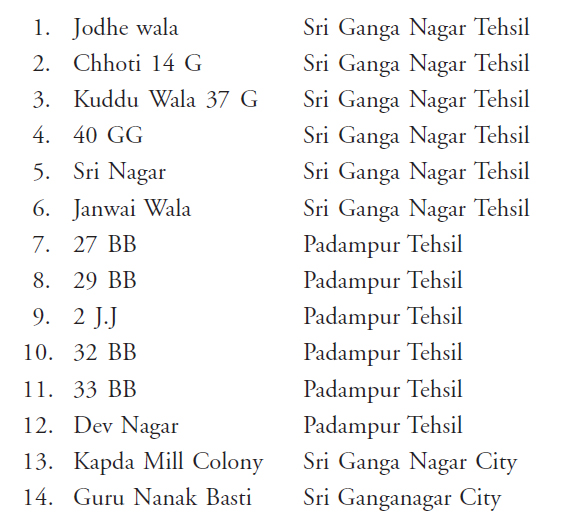 Tanka- Conventional system for water conservation: Running water is pure water. In Rajasthan this proverb stands on shaky ground, for here the water in Kund, Kundi or Tanka (pond, small pond or reservoir) remains pure throughout the year and some times even more. The principle behind this is simple, to hold the drops of rains in a very clean space and stock it. Tankas can be seen in almost every village or dhaanes of Jaiselmer.
Tanka- Conventional system for water conservation: Running water is pure water. In Rajasthan this proverb stands on shaky ground, for here the water in Kund, Kundi or Tanka (pond, small pond or reservoir) remains pure throughout the year and some times even more. The principle behind this is simple, to hold the drops of rains in a very clean space and stock it. Tankas can be seen in almost every village or dhaanes of Jaiselmer.
Wherever any space is available, people whitewash it and make a sloping angan (courtyard) there. The angan from where rainwater is collected for the Tanka is called agor. Throughout the year, the agor is kept spotlessly clean. The water slops down the agor to the circumference. At the mouth of the tanka clean slop is made. A device is also conceived to take care of the dust that comes into the water. Thus the water is cleaned before it reaches to the tanka. Tanka is properly covered on one corner the aperture is covered with a clean lid; which can be removed to fill the water in the bucket. Throughout the year the water of tanka is used for drinking and for kitchen work. Women also add one or two pots of water whenever they can.
The very first precaution, which is taken, is to ensure the thorough cleanliness of the tanka, from time to time, particularly before rain starts, the tanka is cleaned.
Tankas are even made in uninhabited places, far from localities, villages and hamlet. Those who undertake the construction of such tankas do not do it for themselves but for society. These tankas are meant for herdsmen and cowherds. In the morning cowherds and herdsmen set out carrying out a flat earthen water pots; the kupari, but by the midday itself the kupari becomes empty. However, they can always find a tanka nearby. At each tanka, one can find a bucket or at least an old tin box with a string attached to it (Mishra 2001).
In sandy regions, wherever a rocky terrain or gravelly soil is found, a tanka is built. However, the biggest tanka is to be considered, can contains about 2,00,000 gallon. It was built 350 years ago at the Jaigarh fort, which is near Jaipur. A tanka of such an immense capacity was built not only to fulfill the need in water of the whole fort, but by enemies, then there would be no shortage of water. The king has gone and with him his army too. Now tourists visiting a city like Jaipur come to the fort, when they reach the fort, after an arduous climb, their thirst is quenched by the cool water of this very tanka (Mishra 2001)
However at many places water pollution is causing problem. In Jodhpur surface water as well as ground water are the main source of drinking water. For instance, water in Jojhri river near Jodhpur has a reddish tinge that is due to presence of large amount of pollutants. The effect is felt in the nearby wells that are downstream of the river. The villages have experienced that the wells have been contaminated as the pollutants have seeped into the ground water and have accumulated in the well water too.
Traditionally, people of the surveyed villages used to collect excess rainwater in tanka and ponds and subsequently used it for drinking and other purposes. Now these villages have drinking water supply system (through Indira Gandhi Canal) but facility for irrigation is negligible.
According to the respondents, the water quality in Jodhpur suffers due to:-
● The water table in this region is high but the water is very saline.
● Rainwater is the only source for irrigation.
● The ground water of this region generally contains large quantity of dissolved salts. The hydrological investigations of the villages have indicated that most of the areas have saline water.
● The principal constituents are sodium and chloride. Sulphate and bicarbonate are present in appreciable amount.
● Due to excess irrigation with saline water, the fertility of soils is deteriorated by adding salt to the soils.
Even in Jaipur the capital of Rajasthan the situation of water crisis is alarming. The town of Kaladera, 60 km outside of Jaipur, has experienced severe water shortage since a Coca-Cola factory was established in the town 6-7 years ago. Reports from the villagers estimate that the water table has dropped at least 80-100 feet in that time. Whereas the level 10 years ago was around 40 feet, it has now gone down to 120-130 feet depending on the area. In the village itself, the only source of water are provided by the government which pumps in water two times a day (morning and evening) for one hour at a time. Other than that, all the wells have gone dry and the only pumps in town have either been supplied by the government or by Coca Cola. While the government has been providing water to the town for an estimated 40-50 years, the duration per day of water services has shrunk in the last 5 years down form having 3 hour periods of water supply a day.
Inadequate Water for Irrigation: A Cause of Social Violence
Not to talk about drinking water, water is not available even for irrigation in sufficient quantity in Sriganganagar and adjacent districts, resulting in protests and violence.
On Oct 28,2004 agitating farmers set ablaze a police station and staged protests in Sriganganagar district where four persons were killed in police firing on 27th October, 2004 prompting authorities to extend curfew to more areas like Gharsana, Rawala, and Anoopgarh ( Joshi 2004 c, Hindu 2004 (a) and Times of India 2004 c).
Demanding release of more water for irrigation and protesting against the police firing, farmers set on fire a police station 20 km near Rawala town, the scene of violence.
Situation could be controlleld when the Army held flag marches in trouble –torn areas. Curfew had been so strictly enforced that even mediapersons could not get passes to visit affected areas. No movement was allowed in Gharsana and Rawala villages and nearby areas.
Farmers in this interior part of the Rajasthan are an agitated lot. Those who were welloff some years ago, have virtually turned paupers. Villagers who owned more than 20 acres are forced to do menial jobs to make both ends meet. The border area is mainly dominated by the Punjabis who cultivate narma variety of cotton and wheat. Most of the villages are those who have settled down hereafter partition or sold their landholdings in Punjab to buy cheap land in this belt. The land that was once mainly barren or was having the wild growth was converted into fertile land by the hardwork of the new Settlers.
Farmer’s agitation was not a political movement. They were demanding just to release the adequate supply of water. The government had taken the decision to reduce the water to farmers in the canal fed areas, from 5.23 to 3.5 cusec per 1000 acres (Hindu 2004b).
If river diversion or interlinking of rivers take place, inter-state as well as intra-state violence will be a common phenomenon beyond the control of police force or army.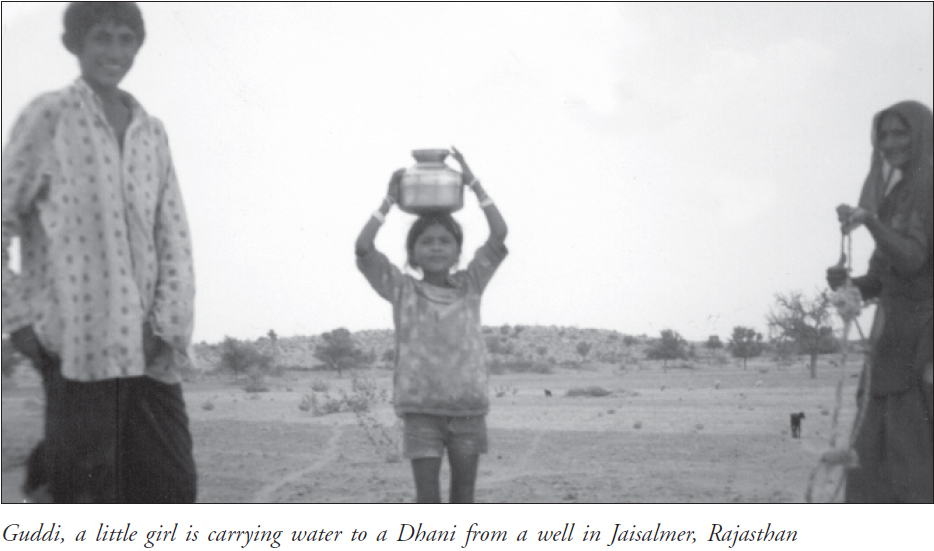
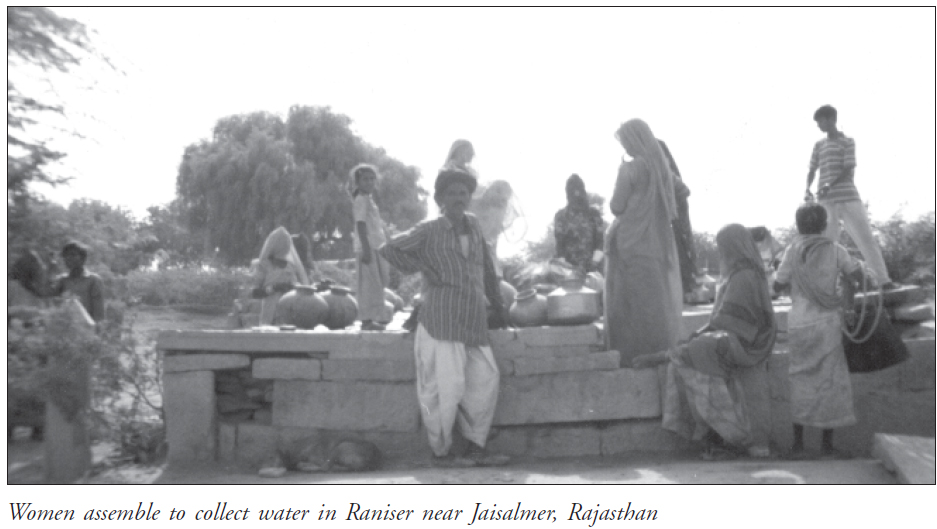
/articles/water-crisis-rajasthan